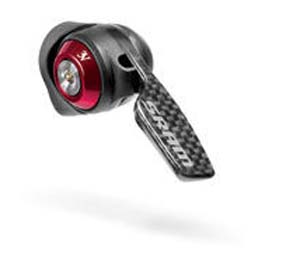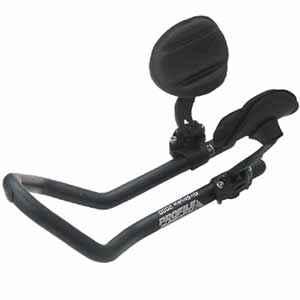Time trialing might be the one time when being “Captain Clip-On” is OK. Yes, I had a clip-on tie once…when I was like six years old. Now, I have clip-on aerobars!
Of all the equipment to get for TTing, clip-on aerobars are probably the most crucial. They come in all sorts of flavors, but they all serve the same purpose–to get you in a more aerodynamic position. Just even adding clip-ons to a standard road bike can make a huge improvement in your times. Depending on the bike and your position, this could make a difference of several minutes over 40K.
So, which bar do you chose? Ummm, I wish that was a simple answer. There are dozens out there in lots of different sizes with lots of different features. I’m going to highlight a few here that I’ve personally tried or noticed that they have a strong following. I highly recommend heading to your favorite LBS to find the right bar for your bike. Triathlon-focused shops tend to carry the most, however, the increased popularity of triathlon has led many LBSs to stock more aerobars.
There are few advantages to doing this: 1) They will be able to guide to the right bar for your bike and needs; 2) They can help you find the right size aerobars; 3) The LBS can help you fit the bars to your bike and adjust the position to your liking. Just a forewarning, make sure the shop has some experience with aerobars that goes beyond slapping them on someone’s hybrid. If you are unsure of where to go, ask a friend or another rider (especially triathletes). They should be able to help steer you (pun intended) to the right place. Now, on to the aerobars…
The first thing you’ll notice about clip-on aerobars are their shape. They come in 3 main styles. The first type is modeled after a downhill skier’s position. These aerobars were popularized by Greg Lemond in the late-80s. The bars were developed by Scott USA, because of their expertise in ski poles. These are probably the style the most people think of when they hear “aerobar”.

Greg LeMond using aerobars modeled after a downhill skier’s position.
The second type of aerobar is what’s referred to as a ski bend or j-bend. These are extremely popular with triathletes and were the bar of choice for professional cyclists several years ago. They are aerodynamic and relatively comfortable for longer races.

Lance Armstrong using ski bend (also known as j-bend) aerobars.
S-bends are the third type of aerobar and are perfect for shorter races. They put the rider in a very aerodynamic position, but can be hard on the wrists. These are also available as straight bars.

Dave Zabriskie using newer s-bend aerobars.
Once you’ve selected the type of aerobar you want, the next step is to get it on your bike. The good news is that this is pretty easy. All you need to do is to determine the diameter of your handlebars (usually 26.0 mm or 31.8 mm) and fit the right adapters for the aerobars. The included instructions should tell you how to do this, and it usually only requires a 4 mm or 5 mm hex wrench. Pretty easy, huh? If the mention of a hex wrench perplexed you, have your favorite mechanic install them.
Many aerobars also allow you to add bar end shifters. This is great addition if you plan on having the aerobars permanently mounted to your bike. Personally, I recommend this if you have a dedicated TT bike. Bar end shifters allow you to change gears without having to get out of the aero position and can be had for $50-$150.
That’s pretty much it. The biggest challenge of aerobars is getting the fit right. As I mentioned above, I recommend finding a good shop with an experienced fitter than can help you. It’s as much trial and error than real science. People might try to sell you on the latest fit systems, but an experienced fitter with a proven track record is your best bet.
I’m profiling about 7 bars here, ranging in price from about $50 to $300. These are true clip-on bars that can be added to just about any bike. Sure, they can be coupled with a base bar for a nice setup on a dedicated TT bike, but this post primarily focuses on their “clip-on” ability.
Profile Design T2+ and T2+ Cobra ($100-$200)
One of the most popular aerobars with triathletes. They are very adjustable and can be fit to both 26.0 mm and 31.8 mm bars. I usually see these on TT bikes, but they can be used with standard road bikes. The T2+ is available in both aluminum (512 g) and carbon (492 g). I had these for about a year and enjoyed being able to play around with my position. For the price, I think these are a great value.
VisionTech TT Minis ($75)
A favorite of the roadie crowd who dabble in the occasional TT. These are lightweight (380 g) and fit most bars, however they have limited adjustability. I recommend these for those cyclists who want to do 1-2 TTs a year using their standard road bike. These are S-bend bars and made of aluminum. These bars can be mounted to either 26.0 mm or 31.8 mm handlebars. Not the fanciest, but a great temporary solution for when you need to go aero.
Syntace C2 ($175)
Another common aerobar with triathletes. These lightweight (376 g) ski-bend aerobars are extremely comfortable and well made. I had a pair on my first TT bike and really enjoyed them. They can be paired with either standard road bars or a base bar. They aren’t very adjustable, but they are available in 3 sizes, plus you can use the included yo-yo and box to help fit your aero position. If you want a combination of comfort and performance, these are a great choice. These bars can be mounted to either 26.0 mm or 31.8 mm handlebars.
Profile Design Airstryke ($100)
The Airstryke offers the “downhill skier” position utilized by Greg LeMond in the 1989 Tour de France. These bars are proven, but have dropped in popularity compared to s-bends and ski-bends. These are nice bars (but heavy at 692 g) and are recommend for folks who want an aero position that’s also relatively comfortable. The Airstykes have flip-up arm pads that allow access to the top of the handlebars. I’ve seen a lot of people leave these attached to their road bike and just flip the arm pads up for everyday riding. These bars can be mounted to either 26.0 mm or 31.8 mm handlebars.
HED Flip Lites ($275)
Steve Hed knows the thing or two about aerodynamics. His aerobars have been used by Lance Armstrong and numerous other professional cyclists. I had seen Hed’s integrated aerobars before, but had never really noticed the Flip Lites until I started reading how much people loved them. These bars have a strong following for their weight (280 g) and performance. Aluminum mounts are combined with carbon or alloy extensions, and the arm pads can be flipped up like the ones on the Airstyrke. These bars can be mounted to either 26.0 mm or 31.8 mm handlebars. Pricey, but great clip-on bars!
Zipp Vuka ($275)
The Zipp name is synonymous with aerodynamic performance. They are best known for their wheels, but they also make aerobars. You might be drooling over Zipp’s $1200 Vuka integrated bars, but the good news is that you can the clip-ons to your bike for about one fourth the price. These aluminum bars are extremely adjustable, relatively lightweight (390 g), and can be mounted to either 26.0 mm or 31.8 mm handlebars. If you’ve got the money, a nice choice. The folks I know that have them, absolutely love them.
Profile Design Sonic CSX ($200)
These are Profile Design’s newest clip-on bars and are they nice! Sorry, I’m a little biased because I have these on my TT bike. I got them for their extremely low stack height. These carbon bars are also very light (328 g), and I have found them relatively comfortable for time trials (not long rides). The one downside is that they’re not very adjustable, but they are available in 3 lengths. These look great when matched with the Cobra base bar.







